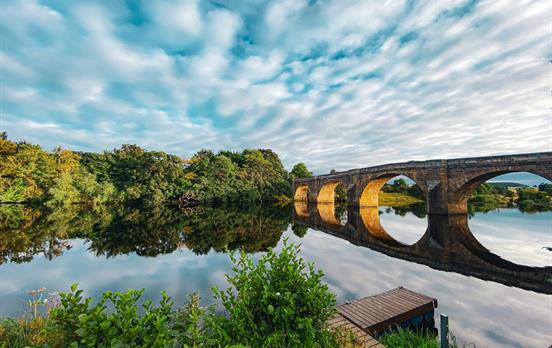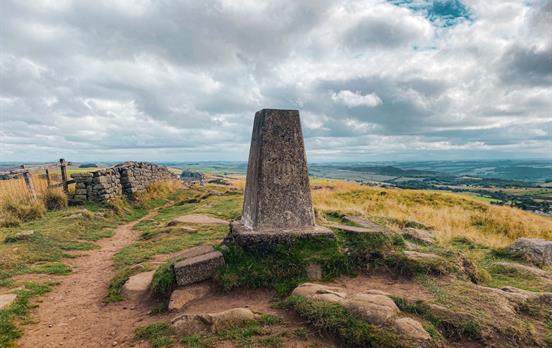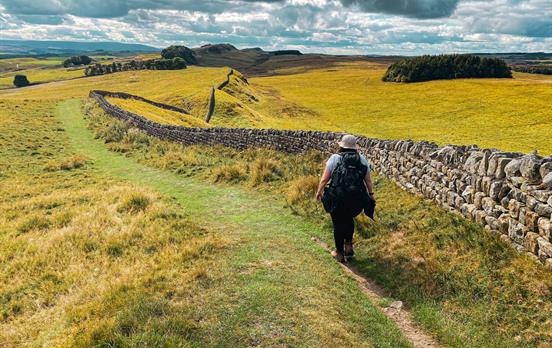Discover Northumberland
-
Why book your Northumberland Walking Holiday with Macs Adventure?
Macs Adventure has been running self-guided walking holidays in Northumberland since 2005. Hadrian's Wall Path was the first, our second-ever trip, it seemed an obvious choice when the trail opened in 2003. It gave people a chance to walk alongside history, through some beautiful landscapes and we just knew that our customers would love it.
After spending some time in Northumberland, we realised that this county had much more to see. We introduced the St Cuthbert’s Way in 2008, another historic trail, crossing the Scottish and English border to Holy Island. This route has an interesting religious history passing close to graceful ruins of Dryburgh Abbey and the cave where St Cuthbert’s remains were stored.
We have been offering the St Oswald’s Way since 2009, a walk that links places associated with St Oswald, The King of Northumbria in the early 7th century. This walk starts in Holy Island and finishes in Hadrian’s Wall country. In 2011, we also added the Northumberland Coastal Path to our collection of national trails in Northern England. The coastal route takes you through an Area of Outstanding Natural Beauty, visiting the unspoiled, deserted beaches of Northumberland.
We now send close to 1200 walkers to Northumberland every year and have over 550 Reviews to back up how much work we put in to ensure every single customer has a great experience. We wanted to provide the freedom to choose your route, itinerary and travel companions and to take each walk at your own pace.
We offer tried and tested Northumberland experiences that get you in comfortable, friendly overnight accommodation in local B&Bs and guesthouses. We carry your bags to lighten your load so you can concentrate on simply putting one foot in front of the other and enjoying the unique culture, food and scenery of Northern England. You can book with confidence that we have it all covered for you.
We want to showcase our expertise, by giving you all the resources you will ever need. In the planning stage, we have free guides, comprehensive videos and a host of staff with their own walking experiences, waiting to answer your questions. On the route, we use high-quality digital mapping as well as the best maps and guidebooks to make sure you find your way.
We love Northumberland and our main aim is to make sure that you do too.
![Why book your Northumberland Walking Holiday with Macs Adventure?]()
-
Essential Facts Northumberland Coast
- Northumberland is England’s northernmost county, right at the top of England. Bordering Scotland there is a long and interesting history to discover.
- It is the birthplace of Earl Grey tea, it was blended in Northumberland in the 1830s at the request of Lady Grey, wife of former Prime Minister Earl Grey.
- Northumberland has more castles than any other English county, it is a legacy of the rich history of this region.
- The Northumberland Coast is a designated Area of Outstanding Natural Beauty. This does not come as a surprise with its well-balanced mix of long beaches, sandy dunes, cliffs and islands.
![Essential Facts Northumberland Coast]()
-
Download our Free Hadrian's Wall Path Guide
Thinking of walking Hadrian's Wall Path, but don't know where to start?
Macs Adventure to the rescue! Simply download our Free 14-page Hadrian's Wall Path guide from the link below to read on your phone, tablet or good old printed page.
![Download our Free Hadrian's Wall Path Guide]()
-
Top Tips for Hadrian's Wall Path
Take a Break - Especially if you are there for a good slice of history, taking a break on the walk is essential. This will give you more time to explore one of the museums on the route. An extra night in Once Brewed, for instance, will let you have more time at Housesteads. For more information, take a look at our blog - 6 best Historical Sites on Hadrian's Wall Path for some inspiration.
Preserve the History - Oh, it is tempting, to walk along the top of the wall, to do a little dance on it for your trip video. However, the wall is pretty old and needs a bit of TLC so being on the wall is frowned upon. Also, walking over lumps and bumps in the ground should be avoided where possible as there could be archaeological goodies waiting to be found. You wouldn't want to be unknowingly crushing some poor footsoldiers amphora!
Make sure you have the right gear - Take a look at our Hadrian's Wall equipment blog for more details – as this can make a big difference to how enjoyable you find the walk. For this particular walk, its all about the boots. Make sure you have comfortable, waterproof boots with a couple of pairs of good walking socks.
Meet the locals. - Quite often the B&B owners and locals are the best people to speak to about ideas for alternative routes, places to see, lunch stops etc. This local knowledge can really help make your walk go as smoothly as possible.
![Top Tips for Hadrian's Wall Path]()
-
St Cuthbert's Way FAQ's
Q: What fitness level is required to fully enjoy this experience?
A: This is a fairly level route with a few more challenging climbs, especially between Kirk Yetholm and Wooler where the route meets the Pennine Way national trail. However, this is nothing that involves too much ascent/descent and it is well suited to the regular walker. At this point, your legs will be well used to the walking and you will be rewarded with far-reaching views over the surrounding hills. Depending on the chosen itinerary the grade of this trip is either easy to moderate or moderate.
Q: Should I check the tides for Holy Island?
A: The final section of your walk is one of the most spectacular and unusual. The scenery is unique and although you follow the road for most of the way to Holy Island, the changing vistas and abundant birdlife will keep you occupied. Make sure you check the tidal chart for the day you pass the causeway and don't forget to check when it is safe to cross the following day. Check out the safe tide crossings here.
Q: Can I visit St Cuthbert's Cave?
A: Yes, on the stretch from Wooler to Fenwick you can visit the cave which is hidden deep in the Kyloe Hills. It is believed the monks of Lindisfarne brought the saint’s body here as a safe resting place. Climb up above the cave and you can enjoy far-reaching views to the Northumberland Coast.
Q: When is the best time of year to walk along St Cuthbert's Way?
A: This historic path is best enjoyed between spring and autumn. Traditionally, April and May have been the most popular time of year to walk the route, as the theory goes that the weather is better. In our opinion, anywhere between April and September should offer a wonderful experience.
For more information, please read our blog called Frequently asked questions about the St Cuthbert’s Way.
![St Cuthbert's Way FAQ's]()
-
Top Reasons to Walk the Northumberland Coastal Path
Northumberland is hot! Deserted sandy beaches, dramatic views and historic castles capture the experience of walking the Northumberland Coastal Path, but there is so much more. Here are the top reasons why you should be walking this unspoilt coastal route this summer!
It is accessible
Northumberland is England’s northernmost county, right next to Scotland. The area is well connected by road, rail, air and sea with excellent transportation links. If you are arriving by car, you are lucky enough to travel on the most scenic routes with views to the rugged coast.
It is a classic national trail
This is a classic point to point walking trip, where you stay in different seaside villages each night. The well-waymarked route follows the coast in most places, apart from the inland stretch between Belford and Holy Island. Although most of the walk is level, there are a few climbs involved but nothing too strenuous for a regular walker.
It is an Area of Outstanding Natural Beauty
The Northumbrian Coast has been recognised by the experts as an Area of Outstanding Natural Beauty and is home to some wildlife that is rare to find and endangered. Thousands of ducks, geese and waders feed on the mudflats, and the Grey Seals are known to breed on the Farne Islands just off the Northumberland Coast.
It has the warmest hospitality
Northumbria is not only steeped in history (read more about this in our blog about the historical highlights of the Northumberland Coastal Path), but it is also known for its warm Northumbrian hospitality and its traditions. Such as the famous oak smoked kippers of which the Robson’s family is a great example. The family business specialises in the traditional method of smoking fish in Craster, where the kippers and salmon are still cured in the original smokehouses that are over 130 years old.
![Top Reasons to Walk the Northumberland Coastal Path]()























































































































































































 Canada
Canada